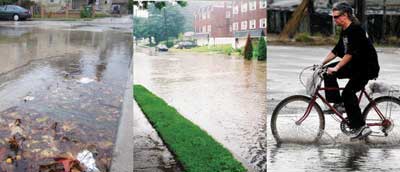Regulating Rainfall in the United States: Proposed EPA Stormwater Rule
Keep Rain On-Site: Requirements for Municipal Separate Sewer Systems
“In recent years, stormwater pollution has become one of the most significant threats to local water quality and public health in many areas of the United States,” writes Art Haddaway, Assistant Editor of WaterWorld Magazine in an article posted in August 2013. “To address these challenges, the Environmental Protection Agency (EPA)  recently announced its plan to propose new municipal stormwater regulations.”
recently announced its plan to propose new municipal stormwater regulations.”
“The projected rulemaking addresses a number of key areas of action, particularly the implementation of a specific on-site performance standard in new and redeveloped sites as projects are built. Other considerations include establishing a single set of stormwater requirements for all municipal separate sewer systems.”
 “Primarily what we’re looking to do is have stormwater controls incorporated into the development and redevelopment process when we have opportunities to incorporate those cost-effective and flexible controls rather than address these urban areas after they’ve already been developed and the costs are much greater, as we’ve done in the past,” stated Chris Kloss of the EPA Clean Water Program.
“Primarily what we’re looking to do is have stormwater controls incorporated into the development and redevelopment process when we have opportunities to incorporate those cost-effective and flexible controls rather than address these urban areas after they’ve already been developed and the costs are much greater, as we’ve done in the past,” stated Chris Kloss of the EPA Clean Water Program.
Mimic the Water Balance: Can the United States Learn from British Columbia?
“The Canadians do appear to be ahead of the US in this field because the US EPA took a really bad approach to Low Impact Design that was based on the premise that enforcing every site to the same standard would somehow fix the problems of water  quality in the US,” commented Paul Crabtree, leader of the Rainwater-in-Context Initiative, after he had reflected on a commentary by Jim Dumont on the view from British Columbia.
quality in the US,” commented Paul Crabtree, leader of the Rainwater-in-Context Initiative, after he had reflected on a commentary by Jim Dumont on the view from British Columbia.
“The USA EPA approach has done some good, but has several crippling drawbacks: a) analysis of the stream/watershed is not part of the protocol: b) sprawl and greenfield development are incentivized since compliance is easier for those development types: c) the regulations became enormously cumbersome (100’s of pages long) because the premise was arbitrary, not based on good science, and required tremendous negotiations in order to achieve passage: and d) the resultant implementation is usually an expensive quagmire that is hated by all except those who are profiting from it.”
To Learn More:
To read the complete article by Art Haddaway, click on Regulating Rainfall: EPA discusses Proposed Stormwater Rule.
Also, click on Proposed National Rulemaking to Strengthen the Stormwater Program
To read the context for the observations by Paul Crabtree, click on Low Impact Development in the United States: “EPA approach has done some good, but has several crippling drawbacks,” says Paul Crabtree


